ISSN ONLINE(2319-8753)PRINT(2347-6710)
ISSN ONLINE(2319-8753)PRINT(2347-6710)
Pramod Sukhavasi 1, Chandan Kumar Patnaikuni 2, N V S Venugopal 3
|
| Related article at Pubmed, Scholar Google |
Visit for more related articles at International Journal of Innovative Research in Science, Engineering and Technology
India is a major rice producing country, and the husk generated during milling is mostly used as a fuel in the boilers for processing paddy, producing energy through direct combustion and / or by gasification. In reality many of concrete structures exposed to severe environmental condition exposed to mineral acids present in soil and severe aggressive condition in case of industrial area where there the durability of concrete structure is important. In the present study, variations such as water absorption and compressive strengths for 0%, 5%, 7.5%, 10% and 15% replacements of RHA concrete when cured with normal water and 5% NaCl solution is investigated. For experimentation process M25 and M35 grade of concrete are selected and variations are studied for 3days, 7days, 28days and 56days respectively. It was concluded that RHA concrete cured with 5% NaCl absorbs less water with increase in replacement proportions of RHA when compared to ordinary concrete. Nacl exhibits early compressive strength that cannot sustain for longer durations, and maximum strength is obtained at 10% replacement which can be adopted as optimum level.
Keywords |
| RHA concrete, Water absorption, compressive strength, Sodium chloride (NaCl) |
INTRODUCTION |
| Sodium chloride (NaCl) also known as rock salt was first used as a deicer in the 1940's. It draws heat from the environment rather than releasing it and it loses most of its deicing effectiveness when temperatures are below 25 degrees F. Sodium chloride is an ionic compound made up of equal numbers of positively charged sodium and negatively charged chloride ions. However, NaCl is known to have erratic effects in concrete and has been reported to cause set acceleration in some cements and retarding effects in others. Though sea water NaCl content of about 3.5% produces the most corrosive chloride salt solution that can be obtained with a corrosion rate of 1.74mm/year NaCl solutions of 5% concentration have been used to investigate durability properties of concrete containing RHA in the laboratory. The silica in the ash undergoes structural transformations depending on the temperature regime it undergoes during combustion. At 550°C – 800°C amorphous silica is formed and at greater Temperatures, crystalline Silica is formed. These types of silica have different properties and it is important to produce ash of the correct specifications for the particular end use. |
LITERATURE REVIEW |
| Abalaka, A. E. et al. [1] studied about Effects of Sodium Chloride Solutions on Compressive Strength Development of Concrete Containing Rice Husk Ash. In his study the effects of sodium chloride (NaCl) solutions as curing medium at concentrations of 5% and 10% on compressive strength of concrete cubes containing 5% rice husk ash (RHA). Concrete cubes containing 5% RHA in NaCl solutions show early compressive strength increase at 3 and 7 days over control cubes; at 28 days concrete cubes containing 5% RHA cured in NaCl solutions recorded higher strength loss compared to control cubes. He concluded that the results of laboratory study suggest that NaCl solutions have compressive strength accelerating properties at early ages that cannot be maintained for long term the strength patterns suggest that saline solutions cause long term compressive strength loss of concrete. Though the advantages in the use of RHA in concrete have been well established in terms of improved concrete performance. D.V. Reddy et al. [2] studied about Marine Durability Characteristics of Rice Husk Ash-Modified Reinforced Concrete. The ash content is about 18-22% by weight of the rice husks. His research has shown that concrete made with RHA as a partial cement substitute to levels of 10% to 20% by weight of cement has superior performance characteristics compared to normal concrete and also, the use of RHA would result in a reduction of the cost of concrete construction, and there reduction of the environmental greenhouse effects. His paper reviews the research investigations during the past three decades. The significant findings from these include higher compressive strength, and the lower chloride-ion penetrability of RHA modified concrete compared to normal concrete. They conclude that the cost-effectiveness and enhanced durability, coupled with its energy efficient contribution to “Turning Down the Global Thermostat”, make RHA a significant contributor to a holistic approach by the concrete industry to the global issue of environmental sustainability. |
MATERIALS AND METHOD |
| In the present investigation Rice husk ash has been used as partial replacement of cement in concrete mixes. On replacing cement with different weight percentage of RHA, the compressive strength properties are studied at 5% of Nacl solution (3, 7, 28 and 56 days). Total five series of specimen of size 100mm × 100mm × 100mm designed in this investigation consist of one series of specimens of normal strength concrete 0% and four series of specimens of RHA concrete with percentage replacements of cement with RHA by 5%,7.5%,10%, and 15% for M25 and M35 grade concrete. A total of 120 cubes have been casted, are cured with Normal water for 28 days and after 28 days they were exposed to 5% Nacl solution. 3 cubes from each series are taken and exposed to 5% Nacl solution for 3days, 7days, 28 days and 56 days. |
| 1. Cement: Cement used in the experimental work is Ordinary Portland Cement (OPC 53 GRADE) conforming to IS: 1489 (Part1)-1991 from a single batch was used for the entire work and care has been taken to store it in airtight containers to prevent it from being affected by the atmospheric and monsoon moisture and humidity. |
| 2. Rice Husk Ash (RHA): Rice Husk Ash used in the present experimental study was obtained from N.K Enterprises Jharsuguda, Orissa. Specifications, Physical Properties and Chemical Composition of this RHA as given by the Supplier and laboratory results are given in the following tables 1, 2 and 3. |
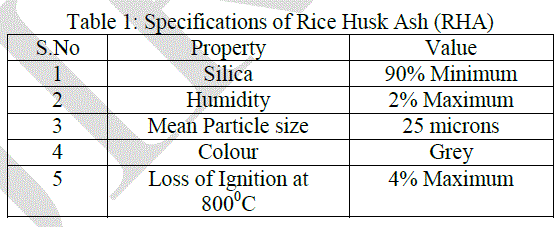 |
| Table 1 represents the laboratory specifications of Rice Husk Ash (RHA) that are adopted from N.K Enterprises, Jharsuguda, Orissa for the present experimental study. Out of all the specifications from the above table, it was observed that loss of ignition at 800oC is 4% maximum which represents the preferable burning of rice husk at controlled conditions. Colour of the burnt ash gives an idea whether it was burnt under controlled conditions of fixed temperature. Thereby grey colour of rice husk ash represents that it was not over burnt in the industry and hence can be adoptable for present study. |
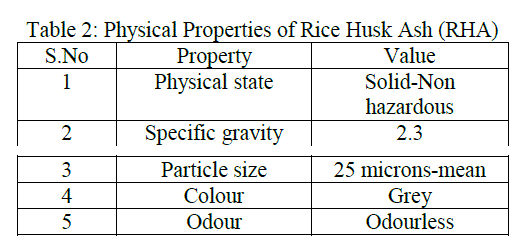 |
 |
| Table 2 represents the physical properties of Rice Husk Ash (RHA) concrete which is used in different replacement levels in the experimental programme. Specific gravity and particle sizes are obtained by the examination in the laboratory. The physical state of the rice husk ash is in solid form which is non-hazardous to the nature and it should not over burn and should be odourless. |
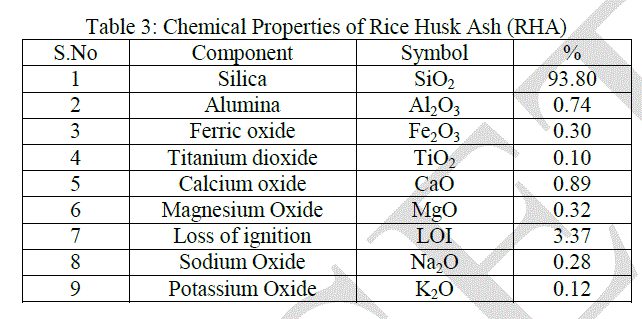 |
| Table 3 shows the chemical properties of Rice Husk Ash (RHA) specified by the supplier and checked with the normal range. From the properties specified it was observed that silica content is the maximum and its volume is about approximately 94% of the entire volume. Potassium oxide contributes very less volume of 0.12 when compared with other components. |
| 3. Fine Aggregate: Fine aggregate was purchased which satisfied the required properties of fine aggregate required for experimental work and the sand conforms to zone III as per the specifications of IS 383: 1970. |
| a) Specific gravity = 2.7 |
| b) Fineness modulus = 2.71 |
| 4. Coarse Aggregate: Crushed granite of 20 mm maximum size has been used as coarse aggregate. The sieve analysis of combined aggregates confirms to the specifications of IS 383: 1970 for graded aggregates. |
| a) Specific gravity =2.64 |
| b) Fineness Modulus = 6.816 |
| 5. Water: Water is an important ingredient of concrete as it actively participates in the chemical reaction with cement. Since it helps to form the strength giving cement gel, the quantity and quality of water is required to be looked in to very carefully. Mixing water should not contain undesirable organic substances or inorganic constituents in excessive proportions. In this study clean potable water conforming to IS: 3025-1986 was obtained for mixing and curing of concrete. |
| 6. NaCl: Sodium chloride is the salt most responsible for the salinity of the ocean and off extra cellular fluid of many multi-cellular organisms. The physical properties of NaCl are tabulated below. |
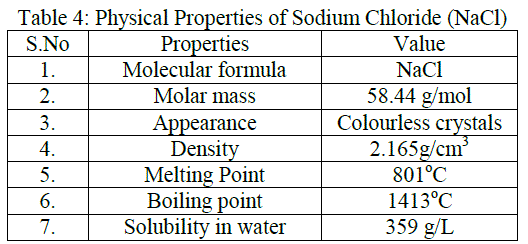 |
| Table 4 represents the properties of sodium chloride solution (NaCl) such as molar mass, melting point, boiling point which can be useful in the freezing temperature effects of NaCl. In the present study 5% NaCl concentration is used for curing of concrete cubes which is prepared by adding 100ml of NaCl to 1litre of distilled water. |
RESULTS |
| In order to study the durability of RHA Concrete exposed to Nacl solution the cubes of RHA Concrete with various replacements, were cast and tested. A replacement of 0%, 5%, 7.5%, 10% and 15% of RHA in cement was chosen to study the variation in compressive strength due to base water curing and find out the rate of water absorption. From the results of the present study and information from the literature, the above mentioned replacement range of 5% to 15% was selected for this study of durability aspects. The pH has been maintained constantly and uniform throughout the study.M25, M35 grade RHA Concrete cubes of size 100mm x100mm x100mm were cast, cured and compressive strength is tested for 7days, 28days and 56days of Nacl solution. The results and discussions of the above tests were presented below. |
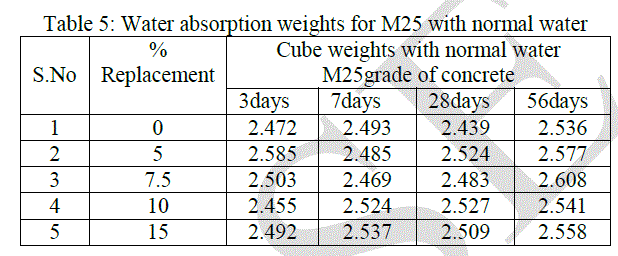 |
| Table 5 shows the mean weights of ordinary concrete cubes and different replacement levels of RHA concrete cubes which undergoes for curing with normal water at the end of 3days, 7days, 28days and 56days respectively. M25 grade is adopted for both ordinary and RHA concrete. It was observed from the above table that increase in RHA replacement from 5% to 15% water absorption is slightly more when compared to 0% replacement i.e., for ordinary concrete at different ages. |
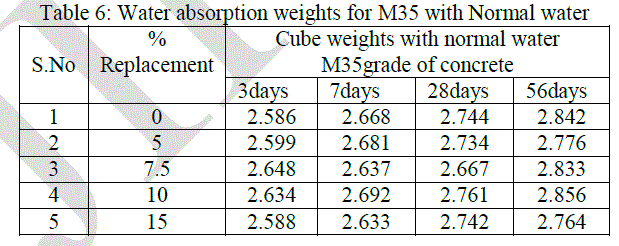 |
| Table 6 shows the mean weights of ordinary concrete cubes and different replacement levels of RHA concrete cubes which undergoes for curing with normal water at the end of 3days, 7days, 28days and 56days respectively. M35 grade is adopted for both ordinary and RHA concrete. Similarly for M35 grade of concrete water absorption is increased with the increase of age when compared to ordinary concrete. |
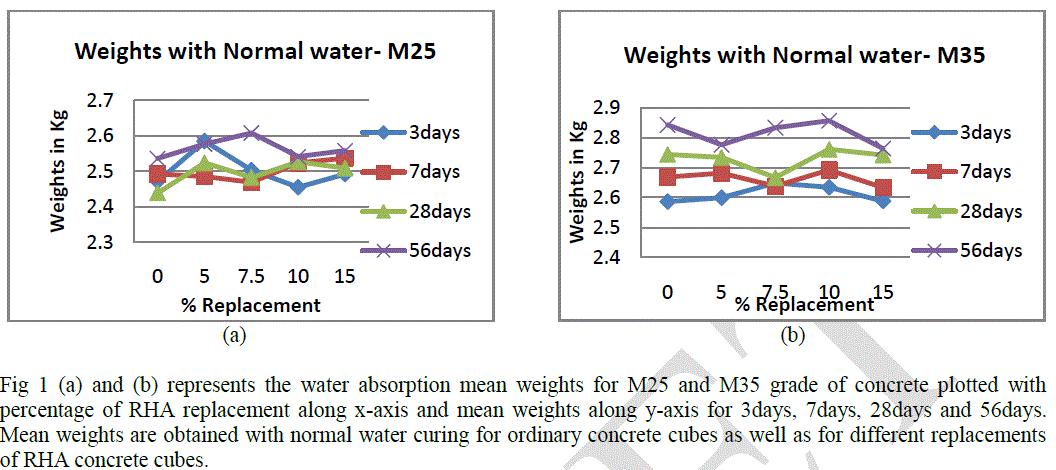 |
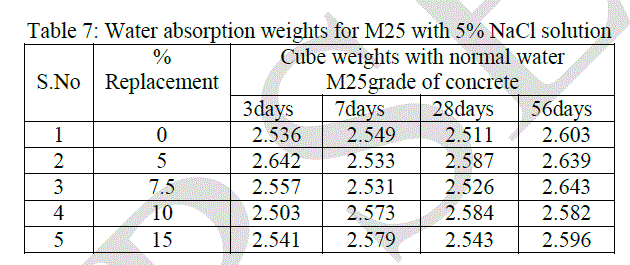 |
| Table 7 shows the mean weights of ordinary concrete cubes and different replacement levels of RHA concrete cubes which undergoes for curing with 5% NaCl solution at the end of 3days, 7days, 28days and 56days respectively. M25 grade is adopted for both ordinary and RHA concrete. |
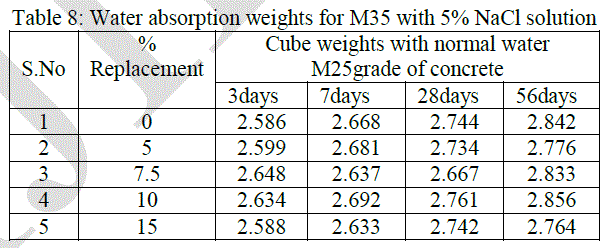 |
| Table 8 shows the mean weights of ordinary concrete cubes and different replacement levels of RHA concrete cubes which undergoes for curing with 5% NaCl solution at the end of 3days, 7days, 28days and 56days respectively. M35 grade is adopted for both ordinary and RHA concrete. |
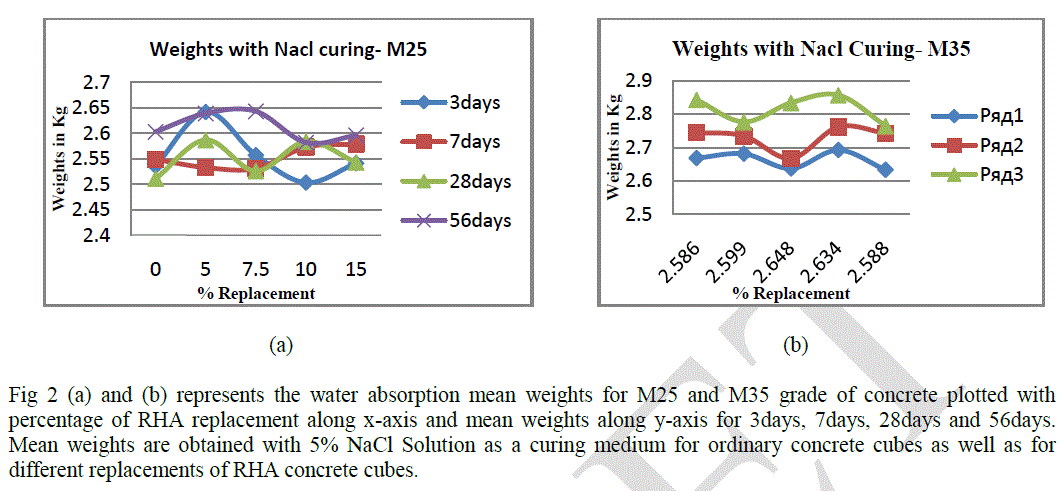 |
`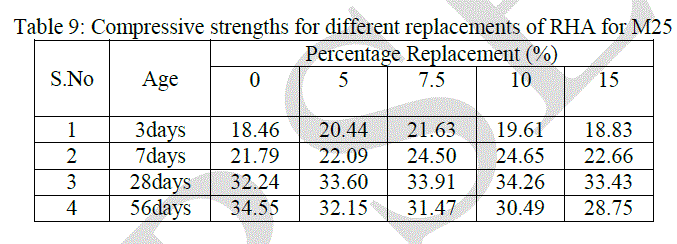 |
| Table 9 shows the compressive strength for different replacements of RHA cubes for M25 grade of concrete. Compressive test was carried at the end of 3days, 7days, 28days and 56days respectively and variations in strengths was evaluated from 0% replacement level to maximum replacement level i.e., up to 15%. |
 |
| Table 10 shows the compressive strength for different replacements of RHA cubes for M35 grade of concrete. Compressive test was carried at the end of 3days, 7days, 28days and 56days respectively and variations in strengths was evaluated from 0% replacement level to maximum replacement level i.e., up to 15%. |
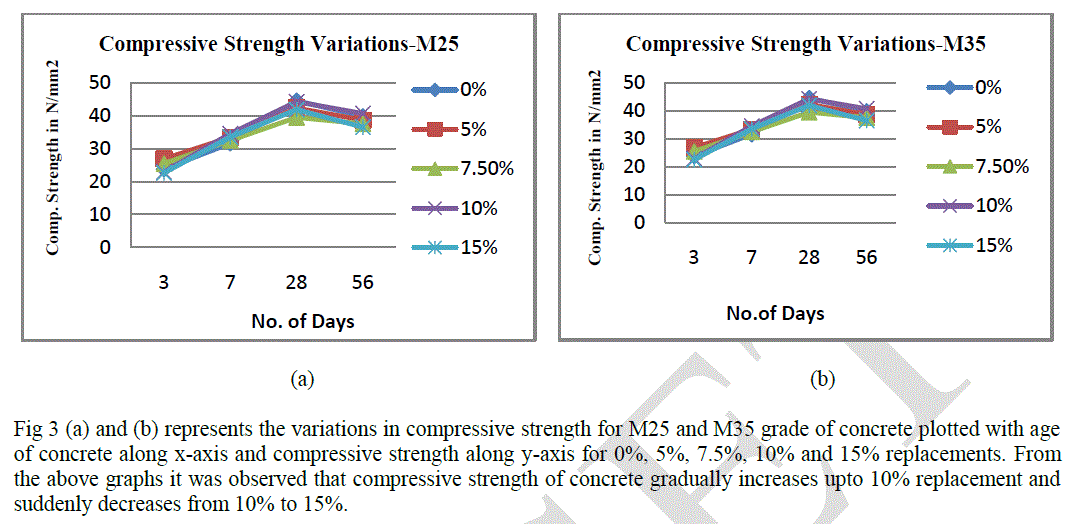 |
RESULTS AND DISCUSSIONS |
| 1. Considering overall Absorption weights for cubes exposed to normal water and 5% NaCl solution as a curing medium for ordinary concrete cubes and RHA concrete cubes from tables 5,6,7 and 8, it was observed that concrete cubes exposed to normal water shows better compressive strength results when compared to RHA concrete. |
| 2. From the above compressive test results from table 9 and 10, it was observed that compressive strength increases at early age i.e., at 3days and decreases with time duration for different replacement levels at an age of 56days with 5% NaCl as curing medium. |
| 3. Water absorption for RHA concrete is less when compared to ordinary concrete and gradually absorption percentage decreases with the increase in replacement of RHA. |
| 4. It was well known that replacement of RHA concrete increases compressive strength, but chloride present in NaCl reacts with the C-S-H gel formed in the heat of hydration process and reduces the strength with increase in the age of concrete. |
| 5. Variation of compressive strength gradually increases from 0% replacement level to 10% replacement level and subsequently decreases at 15% replacement level. So for 5% Nacl solution used for curing, 10% RHA replacement level can be adopted as optimum level. |
| 6. This study shows that RHA concrete has less water absorption capacity when compared to ordinary concrete and thereby increases the durability. |
CONCLUSIONS |
| 1. NaCl has compressive strength accelerating properties at early ages that cannot be sustain for longer durations.` |
| 2. The strength pattern suggests that saline solutions cause long term compressive strength loss of concrete. |
| 3. The above results shows progressive loss of compressive strength for 5%, 7.5%, 10% and 15% replacement of RHA concrete when compared to 0% replacement i.e., for ordinary concrete. |
| 4. 5% NaCl solution used as curing medium for RHA concrete, 10% RHA replacement can be adopted as optimum level. |
| 5. The use of RHA could improve the compressive strength, but in the present study has shown that concrete containing RHA could be more susceptible to sodium chloride attack than ordinary concrete. |
| 6. This particular study is relevant and useful for the structures in coastal areas with saline environment. |
References |
|